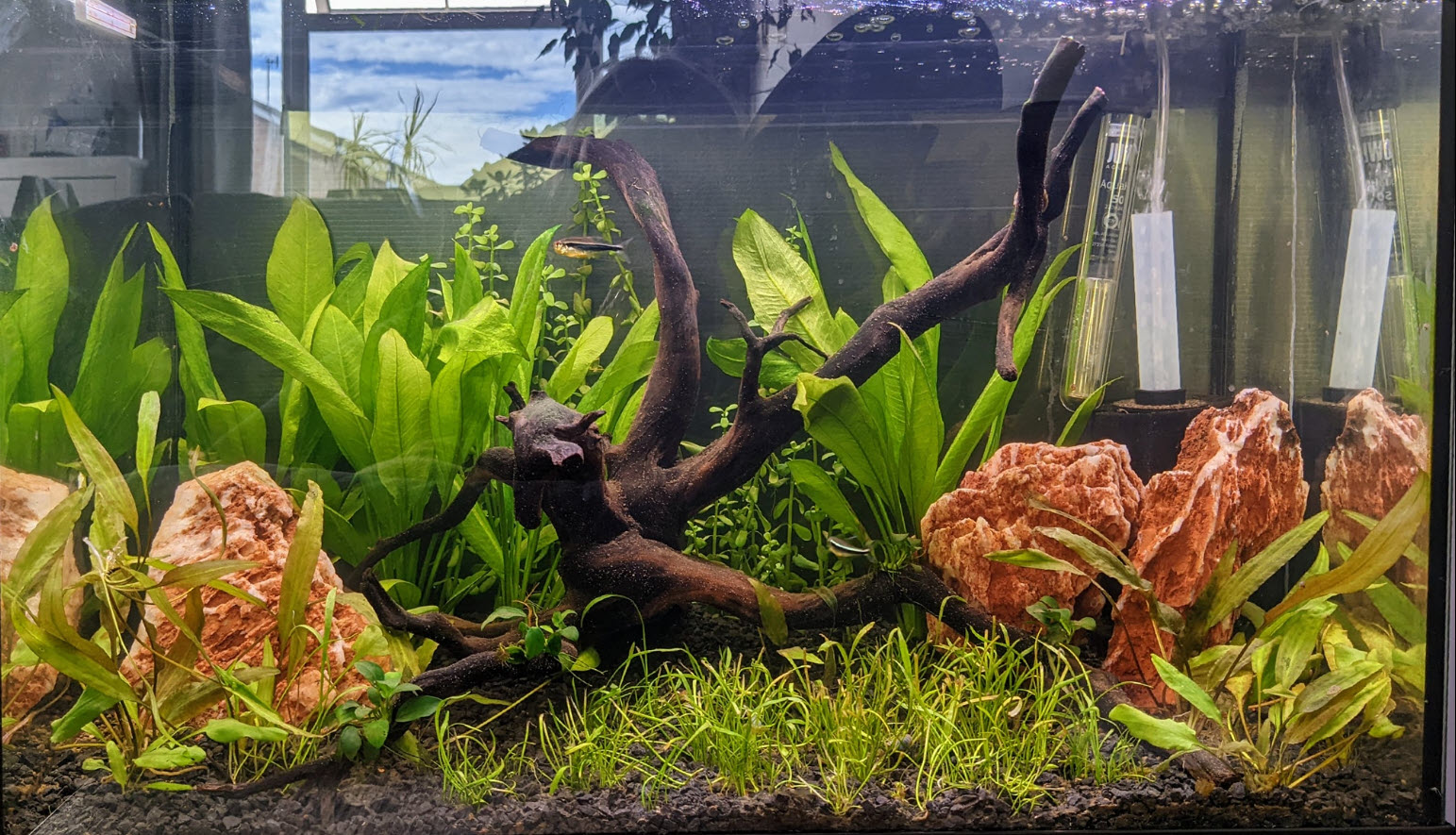
Below we go into two designs of DIY undergravel filters. The first is a somewhat expensive but robust PVC pipe design. The second design is a cheaper but less robust design which uses a plastic grid from the needlepoint hobby.
DIY PVC Pipe Undergravel Filter
A few commentators have now ask about do-it-yourself undergravel filters made from half inch PVC pipe. So I’ve come up with a DIY design. But one should be warned, the cost of all the fittings and pipe involved is two to five times the cost of just buying an under-gravel filter from Petco or Amazon. So this PVC pipe design is only for those interested in a DIY project, or in a country where under-gravels are ridiculously expensive (like Canada).
Note there are other designs on YouTube. All these designs seen to just go around the periphery of the aquarium. A few have one cross branch. These designs just won’t do a lot of filtration as most of the gravel will not have any flow through it.
My design has as many cross branches as one can have. This is the basic design:
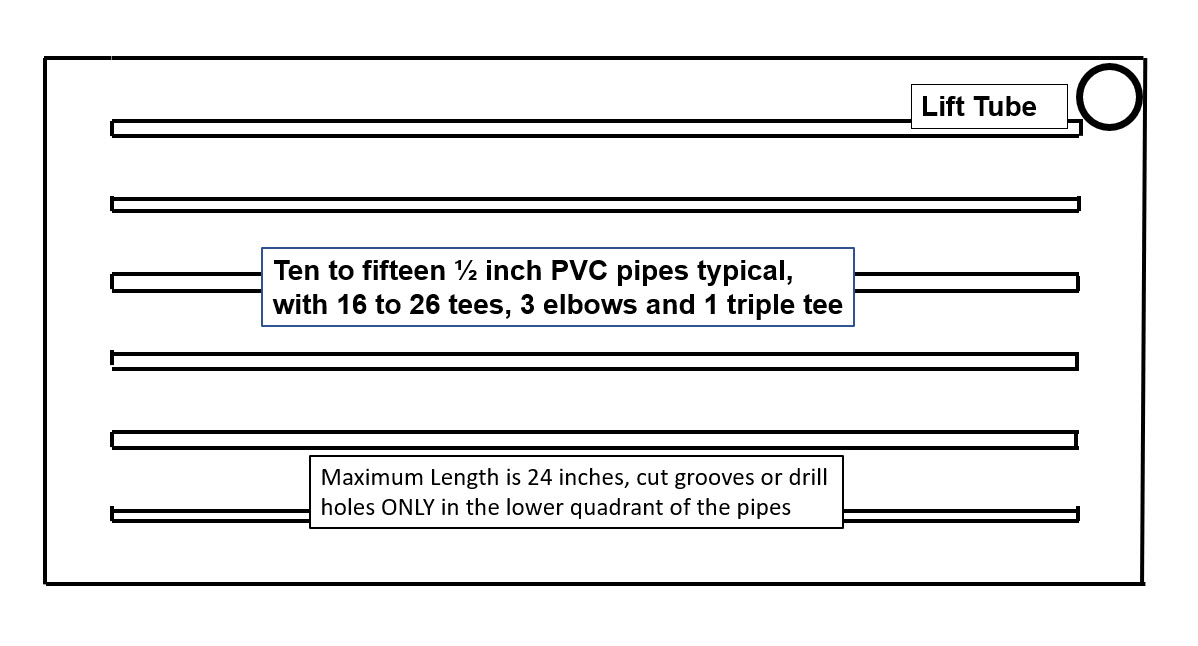
Drill holes a quarter inch apart or cut grooves one inch apart in the PVC cross members. Note if one wants to make a cheaper design it the 8 to 13 tees on the left can be replaced with ten to fifteen PVC caps. This shouldn’t affect the efficiency any.
Key to this design is the modification of the Tees to allow close positioning of the PVC pipe. If you don’t shorten the legs on the tees one will spread the PVC out to the point where I think its effectiveness will be affected.
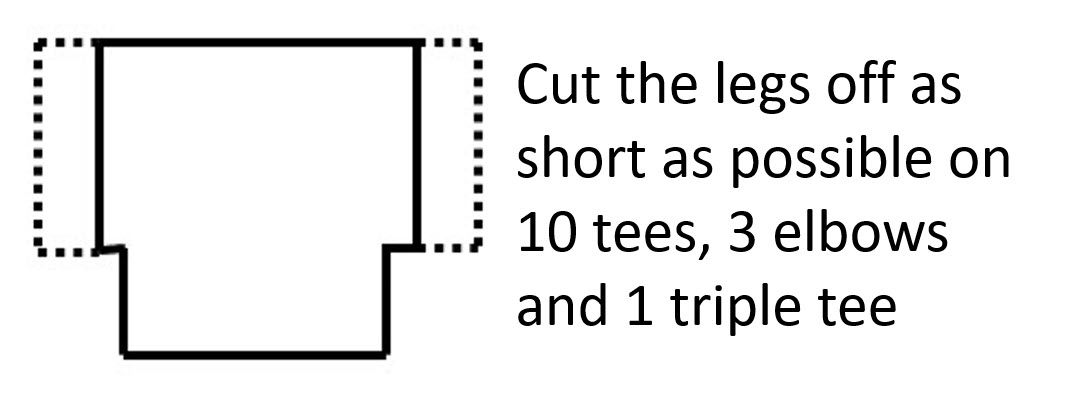
This design is especially useful where large fish are involved. An Oscar can remove the air lift on a standard undergravel filter in all of about two seconds. They have far more difficulty with a solid schedule 40 PVC design, especially if the design in buried under four inches or so of gravel.
Making a Plastic Mesh Undergravel
One idea I’ve had for quite a while is to use the Plastic Mesh Canvas sheets that needlepoint hobbyists use to make an undergravel filter. Simply buy the following item:
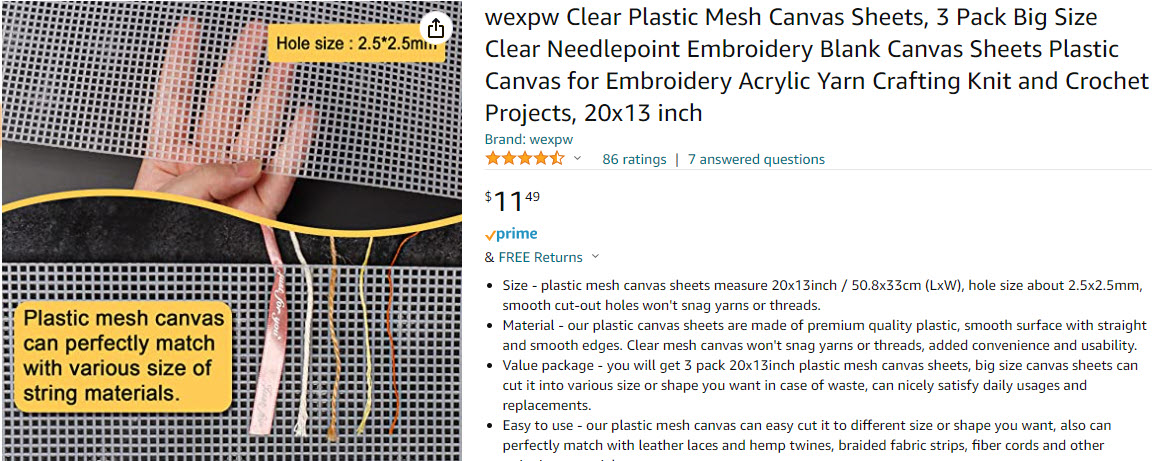
It is important to get the large size sheets with the SMALL 2.5 mm. x 2.5 mm holes. Larger holes will let the gravel fall into the mesh. Cut the mesh to the needed size.
Then get some checkers. Yes, I said checkers, the old table game pieces. These:
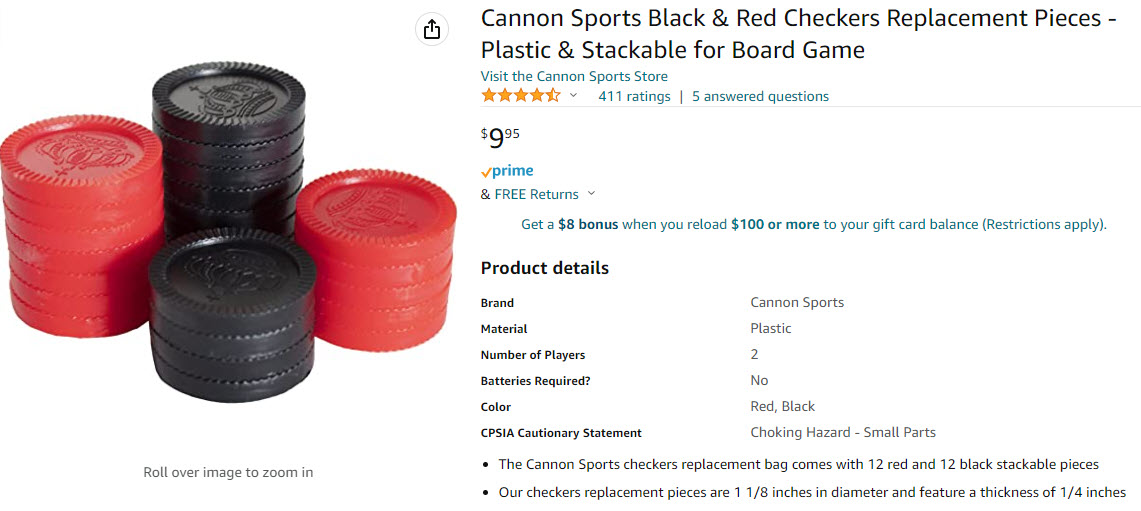
If checkers are not available, the plastic caps from water bottles will work just fine. Get a good gap filling adhesive like an epoxy (not silicone, silicone does not stick well to plastic!). Hot melt guns are great. Glue a checker every four inches around the periphery of the plastic mesh. Then glue a checker every four inches across the middle of the cloth. If you are using water bottle tops, use a three inch spacing.
Then glue several three inch by three inch pieces of mesh to one back corner. Cut a hole in the build-up to the size of a riser tube and glue a riser tube in place. This will take some fabricating skill but it is surprisingly easy. You can cut some quarter inch wide strips and put them around the periphery to seal the gravel out but it really isn’t necessary. You now have a surprisingly cheap undergravel filter.
Note if one wants a higher plenum one can uses plastic pot scrubbers in place of checkers, underneath the mesh. This would add to the filtration capacity of the under gravel filter. Just another idea.
Unconventional Hook-ups
Some advocate hooking up a canister in series with an undergravel filter. We DO NOT recommend this. The problem comes if the canister springs a leak (a common occurrence!). If this happens you can literally drain all the water in an aquarium and kill all the fish.
.
Return to Filters Menu
.
Aquarium Science Website
The chapters shown below or on the right side in maroon lead to close to 400 articles on all aspects of keeping a freshwater aquarium. These articles have NO links to profit making sites and are thus unbiased in their recommendations, unlike all the for-profit sites you will find with Google. Bookmark and browse!
.
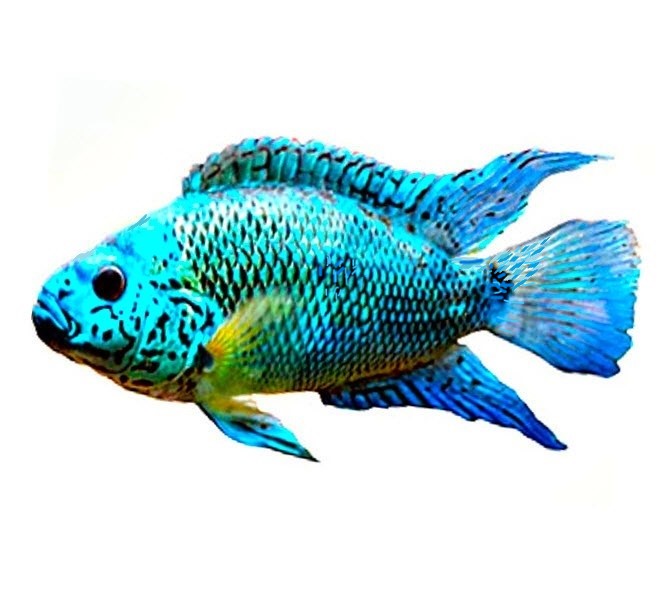
Dave says
In reply to David ….. I would drill 2 mm holes. And holes in the top quarter of the pipe will simply plug with gravel as the gravel settles in to place.
David Parsons says
Hi Dave,
Re: the DIY PVC pipe design.
Assuming that 3-6mm gravel is used, what size holes would you drill into the pipe? And why not drill them into the upper quarter of the pipe?
PS: You should be proud of your website. It’s easily the best source of aquarium related information on the internet.
Regards,
David
Dave says
In reply to Yury …. Yes half a micron holes PROBABLY will become plugged with time. I avoid sand and small plenum holes just because of such a probability. But I can’t say for certain it will occur as I’ve never tried it.
Yury says
Hi Dave,
After reading your articles, I decided to make a Under Gravel Filter (UGF) in my new aquarium according to your recommendations. In my aquarium there is sand (0.8-1.4 mm). Therefore, to prevent sand from penetrating into the plenum, I want to use a separating Mosquito net with a very small mesh holes (0.5 x 0.5 mm).
In this regard, I am afraid that such a small mesh can become clogged with dirt over time (1, 2, 3… 5 years) and impede the flow of water into the plenum. In your opinion, is there a risk of small mesh holes (0.5 mm) becoming clogged with dirt?
Thank you for your answer and your scientific work!
Russell Sniady says
Here’s a construction I learned from a marine biologist. I’ve used it for salt and freshwater.
From the top: substrate, fiberglass cloth, egg crate light ceiling panels (https://www.homedepot.com/p/PLASKOLITE-4-ft-x-2-ft-Suspended-Egg-Crate-Light-Ceiling-Panel-1199233A/202025149) pieces of egg crate panel supporting the sheet, PVC airlift tubes and air stones. I’ve had to secure the tubes to the egg crate only once, for a common octopus.
Hope this is useful
Anonymous says
Thanks a million!
Dave says
In reply to Kieran …. looks good to me Go for it.
Kieran says
Here’s the link
https://www.amazon.co.uk/Hemobllo-Undergravel-Breeding-Accessories-Substrate/dp/B0CBMN66TY?source=ps-sl-shoppingads-lpcontext&ref_=fplfs&psc=1&smid=ASCD433CKKR99
Kieran says
Hi Dave, I’ve got enough of these clip together ugf plates to do my 125gallon tank (link below) they are 1inch high and seem quite sturdy once clipped together. I see Kevin Novack use them for his slow moving plenum design. Would these work just fine hooked up to two power heads at either end with my setup or would you recommend less space under the plates? Thanks
Dave says
In reply to Erika …. Roots do grow into the plenum. I just ignore them.
Erika says
Thank you for this down to earth, informative site! It’s so good to have my ‘logic’ affirmed.
I’ve always wanted to use an undergravel filter because of the filtration benefits, but I also wanted a heavily planted tank.
What is your experience regarding root growth within the plenum? Is this an issue? If yes, how do you deal with it?
EW
Bhuwan Chander says
Hi Dave,
Thanks a lot for your prompt response. I will keep you bothering if there is any doubt, in future 😀
Dave says
In reply to Bhuwan … Yes go to a 15 watt powerhead. And wait a few weeks (four) before adding more stock. But note that if you increase your stocking at a slow rate you can have a lot of fish (and I mean a LOT of fish) in that tank. Sounds like a great setup.
Bhuwan Chander says
PS
Forgot to mention that in my 100 gallon tank has an undergravel filter.
Bhuwan
Bhuwan Chander says
Hi Dave,
Thanks, for your quick responses.
Bothering you again. I have 100 gallon aquarium with 4 inches of gravel. A 15 W pump used for top filter doesn’t have enough flow, it is sort of trickling. Should I replace it with a proper powerhead, 5 W powerheads are not available. Can I use 15W poerhead rated for 1000 lph? Secondly, I have a 40 gallon sump and I have replaced all the media consistently of ceramic rings with big 72 bright colored pot scrubbies a week ago. My current stock is 3 big tinfoil barbs (Altus variety), 2 fully grown parrot cichlids and 2 medium sized parrot chichlds. Will the newly added pot scrubbies take time to mature? The water is crystal clear. I want to add a few more tinfoil bars (Altus varieties). Is the undergravel filter plus the newly added media support addional fishes?
Regards
Bhuwan
Bhuwan Chander says
Hi Dave,
Thanks for your timely reply. I would also like to thank you for creating such a wonderful site which has helped me to understand a lot of nitty gritty of this aquarium hobby. I am in this hobby for the last many years but actively for the past 10 years.
After discovering your website, a lot of my doubts have cleared up which has really helped a lot in having a stress-free hobby and now I am truly enjoying this hobby. Also I have helped many an aquarist who were on the verge of leaving this hobby due to the work involved in this hobby, with your website’s guidance. Now, they too have begun to enjoy fish keeping, with all your guidance.
Thanks a ton from the bottom of my heart for creating such a wonderful website.
Regards
Bhuwan
Dave says
Bhuwan …… Face down
Bhuwan Chander says
Hi Dave,
In DIY undergravel using pipes, should the holes or cuts face down or up? Kindly reply soon as I am doing this project tomorrow.
Bhuwan
Dave says
In response to Tyler …. I had an Oscar with a stand undergravel filter for many years. I did have to glue the lift tube into place to keep the bugger from removing it.
Tyler Davis says
I’m interested in building this to use with a 120g aquarium with a Oscar plus a k1 sump.
Do you have any videos of building this?
How do Oscars do with the lift tube? I’m worried it might try to knock the tube off
Dave says
In reply to HP …. Caps off of water bottles will work just fine. Just change the spacing to every three inches.
H P says
Dear Sir. Do you have any suggest about the space between the bottom of tank to UGF’s mattress ? (aka the thickness of checkers above). Sadly my area not familiar with it, but I’m thinking about using caps of water bottle to glue it instead.
Good day Sir!